Stellar Physics
As the Sun is very close, it is very easy to collect enough photons to
perform detailed observations of the many different phenomena it displays,
however, when compared to other stars, the Sun can be considered as quiet
and inactive. Even in the most extreme case, a solar flare may give up to
a 1% change in the Sun's white light intensity, but there are some stars w
here the flare intensity can reach 100 times that of the stellar luminosity.
Adding to this the highly energetic phenomena found in the universe, like
gamma ray bursts and supernovae, there is a vast range of high energy
astrophysical phenomena that requires our attention.
Using the Subaru telescope in Hawaii, the Kepler satellite and a number of
domestic telescopes, we work to observationally investigate the highly
energetic astrophysical phenomena.
Superflares
The launch of the exoplanet hunting mission Kepler gave us high photometric
sensitivity observations of stars to allow the transit of planets to be
observed. This sensitivity to small changes in the intensity of the star
also made it perfect to study the small increases in white-light intensity
that would be expected when a superflare, flares with energy 1033-1036 erg,
occurs on a star. By investigating the intensity variation of many G-type
stars, a total of 365 flares on 148 solar-type stars was discovered (Maehara
et al 2012). More surprisingly, none of these stars were found to have a hot
Jupiter, previously believed to be an essential ingredient for a slow-rotating
star to produce a superflare. This leads to the very important question:
'Can superflares occur on out Sun?' (Shibata et al 2013).
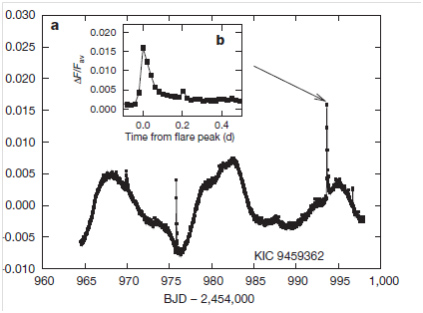 Figure1: Light curve, observed by Kepler, of KIC 9459362.
The long period modulation is believed to be caused by starspots
and the sudden jumps in intensity are superflares.
The superflare research project heavily involved a group of undergraduate
students, who played an essential role in the development project, and a
number of the students published first author papers. Shibayama et al (2013)
extended the work of Maehara et al (2012) by further analysing the Kepler
data finding a total of 1547 superflares on 279 stars, and they even found
evidence of Sun-like stars having a superflare every 100 days.
They attributed this high level of activity to a very large starspot.
Using high dispersion spectroscopy of the Subaru telescope, S. Notsu et al
(2013) were able to show that the slow rotating G-type star (KIC 6934317)
showed significantly higher magnetic activity than our sun does, strongly
supporting the hypothesis that superflare are caused by super-starspots.
To further investigate this idea, Y. Notsu et al (2013) investigated the
long duration light curve fluctuations observed (as visible in Figure 1)
in the Kepler data to estimate the stellar rotation period and starspot
size for each star.
References:
Maehara et al., Nature, Volume 485, Issue 7399, pp. 478-481 (2012).
Shibata et al., Publications of the Astronomical Society of Japan, Vol.65,
No.3, Article No.49, 8 (2013).
Shibayama et al., The Astrophysical Journal Supplement, Volume 209, Issue 1,
article id. 5, 13 pp. (2013).
S. Notsu, Publications of the Astronomical Society of Japan, Vol.65, No.5,
Article No.112 13 pp. (2013).
Y. Notsu et al., The Astrophysical Journal, Volume 771, Issue 2,
article id. 127, 10 pp. (2013).
Investigating nearby Supernovae
The type Ia supernovae play an extremely important role in Astronomy as
standard candles allowing the huge distances in the Universe to be estimated
accurately. This relies fundamentally on the state of the star when it goes
supernova being almost exactly the same, i.e. they go supernova when they
reach the Chandrasekhar limit of 1.4 solar mass. Therefore validating this
hypothesis is of great importance for studies on the evolution of the universe.
Recent observations using Hiroshima University's 1.5m telescope of type Ia
supernovae in nearby galaxies have revealed very interesting results.
Yamanaka et al (2014) used photometric and spectroscopic observations of the
nearby type 1a Supernova 2012ht from 15.8 days before to 49.1 days after the
B-band maximum. Because the supernova was discovered very close to its
expected explosion date, it is one of very few supernova to have a well
constrained rise time (see Figure 2). The decline of the light curve showed
that this supernova was an intermediate supernova (between normal and
subluminous supernovae), making this the first intermediate supernova with
such a well constrained rise time.
Figure1: Light curve, observed by Kepler, of KIC 9459362.
The long period modulation is believed to be caused by starspots
and the sudden jumps in intensity are superflares.
The superflare research project heavily involved a group of undergraduate
students, who played an essential role in the development project, and a
number of the students published first author papers. Shibayama et al (2013)
extended the work of Maehara et al (2012) by further analysing the Kepler
data finding a total of 1547 superflares on 279 stars, and they even found
evidence of Sun-like stars having a superflare every 100 days.
They attributed this high level of activity to a very large starspot.
Using high dispersion spectroscopy of the Subaru telescope, S. Notsu et al
(2013) were able to show that the slow rotating G-type star (KIC 6934317)
showed significantly higher magnetic activity than our sun does, strongly
supporting the hypothesis that superflare are caused by super-starspots.
To further investigate this idea, Y. Notsu et al (2013) investigated the
long duration light curve fluctuations observed (as visible in Figure 1)
in the Kepler data to estimate the stellar rotation period and starspot
size for each star.
References:
Maehara et al., Nature, Volume 485, Issue 7399, pp. 478-481 (2012).
Shibata et al., Publications of the Astronomical Society of Japan, Vol.65,
No.3, Article No.49, 8 (2013).
Shibayama et al., The Astrophysical Journal Supplement, Volume 209, Issue 1,
article id. 5, 13 pp. (2013).
S. Notsu, Publications of the Astronomical Society of Japan, Vol.65, No.5,
Article No.112 13 pp. (2013).
Y. Notsu et al., The Astrophysical Journal, Volume 771, Issue 2,
article id. 127, 10 pp. (2013).
Investigating nearby Supernovae
The type Ia supernovae play an extremely important role in Astronomy as
standard candles allowing the huge distances in the Universe to be estimated
accurately. This relies fundamentally on the state of the star when it goes
supernova being almost exactly the same, i.e. they go supernova when they
reach the Chandrasekhar limit of 1.4 solar mass. Therefore validating this
hypothesis is of great importance for studies on the evolution of the universe.
Recent observations using Hiroshima University's 1.5m telescope of type Ia
supernovae in nearby galaxies have revealed very interesting results.
Yamanaka et al (2014) used photometric and spectroscopic observations of the
nearby type 1a Supernova 2012ht from 15.8 days before to 49.1 days after the
B-band maximum. Because the supernova was discovered very close to its
expected explosion date, it is one of very few supernova to have a well
constrained rise time (see Figure 2). The decline of the light curve showed
that this supernova was an intermediate supernova (between normal and
subluminous supernovae), making this the first intermediate supernova with
such a well constrained rise time.
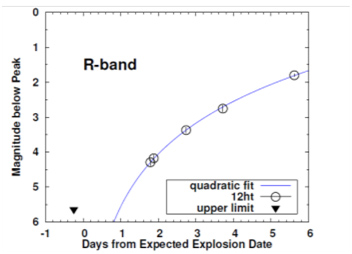 Figure 2: R-band magnitude of type 1a Supernova 2012ht for the first
few days from the explosion. Based on a quadratic fit to the data,
it was possible to accurately calculate the time of the explosion.
References:
Yamanaka et al.,
The Astrophysical Journal Letters, Volume 782, Issue 2,
article id. L35, 6 pp. (2014).
X-ray Binaries, and other compact object binaries
Binary systems, systems composed of a host star and a companion, evolve on
a variety of ways that are very different from that of single stars.
The more massive star in a binary evolves more rapidly, eventually becoming
a compact object, such as a black hole, neutron star, or white dwarf in the
case that its mass is sufficient. This compact object accretes masses from
the companion star, and as this mass is accreted it forms a disk around the
compact object. Accretion disks present many kinds of dramatic phenomena,
such as jets and outbursts.
Nakata et al (2013) investigated the dwarf novae MASTER OT J211258.65+242145.4
and MASTER OT J203749.39+552210.3 during outbursts in 2012. In both of these
systems there were many rebrightenings after the main superoutburst (see
Figure 3), and two kinds of small-amplitude short-term variations, called
early superhumps and (ordinary) superhumps, were observed. From this, we
hypothesised about the importance of gas pressure effects in the accretion
disk, and proposed that WZ Sge-type dwarf novae with multiple rebrightenings
and SU UMa-type dwarf novae without rebrightening are located in the same
place on the evolutionary track.
Figure 2: R-band magnitude of type 1a Supernova 2012ht for the first
few days from the explosion. Based on a quadratic fit to the data,
it was possible to accurately calculate the time of the explosion.
References:
Yamanaka et al.,
The Astrophysical Journal Letters, Volume 782, Issue 2,
article id. L35, 6 pp. (2014).
X-ray Binaries, and other compact object binaries
Binary systems, systems composed of a host star and a companion, evolve on
a variety of ways that are very different from that of single stars.
The more massive star in a binary evolves more rapidly, eventually becoming
a compact object, such as a black hole, neutron star, or white dwarf in the
case that its mass is sufficient. This compact object accretes masses from
the companion star, and as this mass is accreted it forms a disk around the
compact object. Accretion disks present many kinds of dramatic phenomena,
such as jets and outbursts.
Nakata et al (2013) investigated the dwarf novae MASTER OT J211258.65+242145.4
and MASTER OT J203749.39+552210.3 during outbursts in 2012. In both of these
systems there were many rebrightenings after the main superoutburst (see
Figure 3), and two kinds of small-amplitude short-term variations, called
early superhumps and (ordinary) superhumps, were observed. From this, we
hypothesised about the importance of gas pressure effects in the accretion
disk, and proposed that WZ Sge-type dwarf novae with multiple rebrightenings
and SU UMa-type dwarf novae without rebrightening are located in the same
place on the evolutionary track.
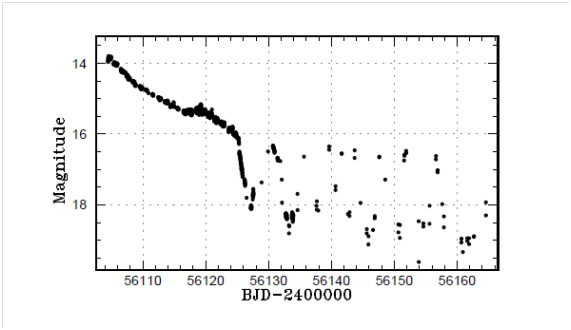 Figure 3: Lightcurve of MASTER OT J211258. The light curve shows
the superoutburst followed by multiple rebrightenings.
References:
Nakata et al., accepted for publication in Publications of the Astronomical
Society of Japan, arXiv:1307.6712 (2014)
The Okayama 3.8m new technology telescope project
The 3.8m new technology telescope that is being constructed in Okayama is
designed to investigate gamma ray bursts, black holes, stellar flares and
other transient objects and phenomena, as well as drive the search for
extrasolar planets (Figure 4). The project is a collaboration between
Kyoto University, Nagoya University, Okayama Observatory and Nano Optonics
Energy.
Figure 3: Lightcurve of MASTER OT J211258. The light curve shows
the superoutburst followed by multiple rebrightenings.
References:
Nakata et al., accepted for publication in Publications of the Astronomical
Society of Japan, arXiv:1307.6712 (2014)
The Okayama 3.8m new technology telescope project
The 3.8m new technology telescope that is being constructed in Okayama is
designed to investigate gamma ray bursts, black holes, stellar flares and
other transient objects and phenomena, as well as drive the search for
extrasolar planets (Figure 4). The project is a collaboration between
Kyoto University, Nagoya University, Okayama Observatory and Nano Optonics
Energy.
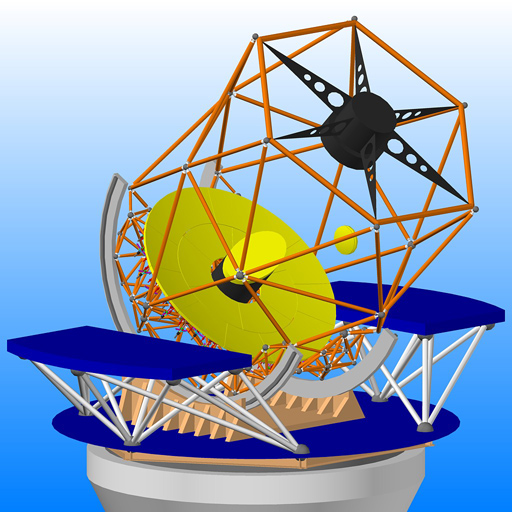 Figure 4: Image of the Kyoto University 3.8m telescope.
Once finished, it will be the largest multi-purpose telescope in Asia.
Japan is at the heart of a region without any 3m or larger class telescopes
(see Figure 5), making this telescope incredibly important for transient
object observations.
Figure 4: Image of the Kyoto University 3.8m telescope.
Once finished, it will be the largest multi-purpose telescope in Asia.
Japan is at the heart of a region without any 3m or larger class telescopes
(see Figure 5), making this telescope incredibly important for transient
object observations.
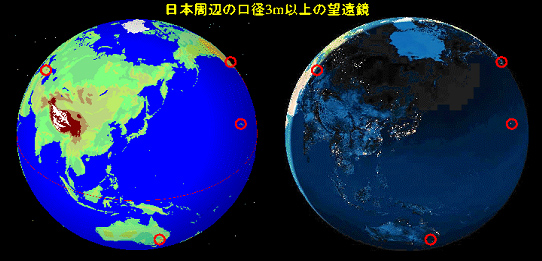 Figure 5: Map showing the positions of telescopes larger than 3m.
Japan is at the centre of a region without a 3m class telescope.
This telescope has the following new technology: 1) mirrors made through
grinding, 2) segmented mirrors and 3) light-weight structure.
The development of these new technologies is a necessary step to lead
towards the new class of giant telescopes, giving this project even
greater meaning.
References:
Website of Kyoto University 3.8m Telescope (in Japanese language)
http://www.kusastro.kyoto-u.ac.jp/psmt/
Figure 5: Map showing the positions of telescopes larger than 3m.
Japan is at the centre of a region without a 3m class telescope.
This telescope has the following new technology: 1) mirrors made through
grinding, 2) segmented mirrors and 3) light-weight structure.
The development of these new technologies is a necessary step to lead
towards the new class of giant telescopes, giving this project even
greater meaning.
References:
Website of Kyoto University 3.8m Telescope (in Japanese language)
http://www.kusastro.kyoto-u.ac.jp/psmt/
|

